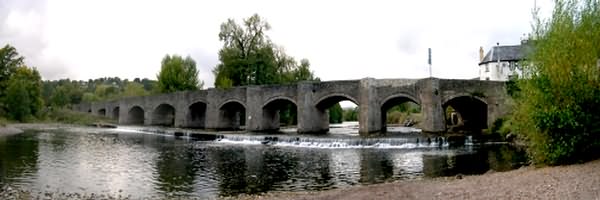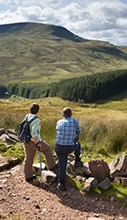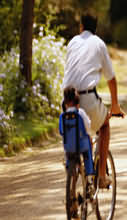The Local Time is Saturday, 27-Jul-2024 07:12:27 CEST |
Crickhowell Tourist Information and Travel Guide |
|
||||
| YOU ARE HERE > Home Page > Places > Crickhowell |
Crickhowell in the Brecon Beacons
|
|||||||||||||||||||||
 |
|||||||||||||||||||||
Crickhowell Castle was built by the Normans and is located in the town centre. It is thought that it begun life as a motte and bailey castle with timber buildings in the 12th century. It was then rebuilt in stone in 1272. Apparently as the castle has fallen into ruin, locals have robbed some of the stone to build surrounding houses so that now only two towers remain. It is also known as Alisby Castle. Crickhowell is mostly renowned for its 17th century bridge that spans the River Usk. It is unusual in that when viewed from its eastern end you can see thirteen arches, but when viewed from the western end of the bridge, there are only twelve. There are many excellent walks on the Black Mountains and the Brecon Beacons. Horse riding, fishing, and canoeing can all be arranged locally. The River Usk, which flows past the village, is renowned for the good trout and salmon fishing.
Crickhowell is approximately 7 miles from Abergavenny the nearest railway station and 13 miles from the market town of Brecon. London is 2 hours, Birmingham 1.5 hours, and Cardiff just 40 minutes. The nearest bus and railway station is Abergavenny, (6 miles). The nearest airport is Cardiff International (45 miles) It is believed that Crickhowell has existed since at least the Iron Age when settlers built the hill fort on Crug Hywel also known as Table Mountain. This dominates the landscape at 1,480 feet (451 metres) above Crickhowell. The area was also influenced by the Romans who built forts within the area. Castell Dinas, north of Crickhowell, are the remains of a castle built in the early Norman period, although before that it was another iron age hillfort. The standing ruins that remain are the northern gate tower that is thought to date from around late 1233. Much of the site is now what looks like grass covered rubble which was once walls and a masonry hall keep. The site is 3 miles southeast of Talgarth at grid reference SO 179 301.
|
|||||||||||||||||||||
|
|||||||||||||||||||||
| BACK TO TOP | |||||||||||||||||||||
|
|||||||||||||||||||||
|
|
|||||||||||||||||||||
|
|||||||||||||||||||||
|
|
|||||||||||||||||||||
Crickhowell in the Brecon Beacons |
|||||||||||||||||||||
| This page last modified Friday, 12-Jul-2019 12:32:10 CEST | |||||||||||||||||||||


 The attractive town centre has several shops, a Post Office and a garage. There are some excellent pubs and restaurants in Crickhowell including the
The attractive town centre has several shops, a Post Office and a garage. There are some excellent pubs and restaurants in Crickhowell including the  At Tretower, a few miles north of Crickhowell just off the A40 is the fairly intact round tower of Tretower Castle and Court. This site contains examples of several buildings from the 12th century castle to a medieval dwelling. This site is a good example of how the transition was made from castle to residential dwelling. Tretower Court is a late medieval defended house which reflects the fashion of wealthy landowners in the 1300-1700 period. Tretower Castle was built much earlier in the 11th century and started out as a motte and bailey castle. Modifications were made adding stone walls, the keep and the great tower until it was abandoned in the 14th century in preference for the Court.
At Tretower, a few miles north of Crickhowell just off the A40 is the fairly intact round tower of Tretower Castle and Court. This site contains examples of several buildings from the 12th century castle to a medieval dwelling. This site is a good example of how the transition was made from castle to residential dwelling. Tretower Court is a late medieval defended house which reflects the fashion of wealthy landowners in the 1300-1700 period. Tretower Castle was built much earlier in the 11th century and started out as a motte and bailey castle. Modifications were made adding stone walls, the keep and the great tower until it was abandoned in the 14th century in preference for the Court.
